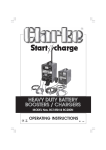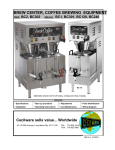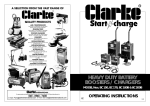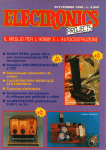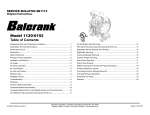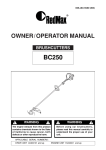Download Clarke BC100N Specifications
Transcript
BATTERY/BOOSTER CHARGER Model No: BC100N Part No: 6210101 OPERATING & MAINTENANCE INSTRUCTIONS 0906 Specifications Max Charge ......................................................... 15Amps Duty Cycle ............................................................ 100% 10A Arith. Max Boost ............................................................. 100Amps Boost/Charge ....................................................... 12Volts (D.C.) Thermal Overload Protection ............................. YES Dimensions (Lxwxh) mm ...................................... 175x130x239 Weight . ................................................................. 4Kg PARTS & SERVICE CONTACTS For Spare Parts and Service, please contact your nearest dealer, or CLARKE International, on one of the following numbers. PARTS & SERVICE TEL: 020 8988 7400 PARTS & SERVICE FAX: 020 8558 3622 or e-mail as follows: PARTS: [email protected] SERVICE: [email protected] When disposing of this product, ensure it is disposed of according to all local ordinances. DO NOT dispose of with general household waste. 2 Thank you for purchasing this CLARKE Battery Charger. Th1s units is designed for charging 12 Volt, lead acid battery and for providing a boost start in the event of a flat battery Before attempting to operate the charger, please read this instruction manual thoroughly, and follow all directions carefully. By doing so you will ensure the safety of yourself, and others around you, and at the same time, you should look forward to the unit giving long and trouble free service. GUARANTEE This product is guaranteed against faults in manufacture for 12 months from date of purchase. Please keep your receipt as proof of purchase. This guarantee is invalid if the product has been found to have been abused in any way, or not used for the purpose for which it was intended, or to have been tampered with in any way. The reason for return must be clearly stated. This guarantee does not affect your statutory rights. CONTENTS PAGE Specifications ................................................................................. 2 Parts and Service Contacts .......................................................... 2 Safety Precautions ......................................................................... 4 Electrical Connections .................................................................. 5 Procedure For Engine Starting ...................................................... 6 Procedure For Normal Charging .................................................. 7 Wiring Diagram ............................................................................... 8 Parts Lists & Diagram ...................................................................... 9 3 IMPORTANT: SAFETY PRECAUTIONS PLEASE READ BEFORE USING THIS UNIT 1. WARNING: Some electronic equipment can be damaged by boost charging or use of start facility. Check your vehicle handbook before using your Start ’N’ Charge. If in doubt consult the vehicle manufacturer. Nevertheless, you should not operate this equipment unless you are fully conversant with vehicle electrical systems, and battery charging techniques. 2. WARNING: Because highly inflammable hydrogen gas is released in the process of battery charging, please remember to switch OFF the charger first, and so avoid sparking which will occur when CONNECTING OR DISCONNECTING LIVE LEADS. 3. Black negative (-ve) lead must always be clipped to the negative, and Red positive (+ve) lead must always be clipped to the positive. When charging with battery installed in vehicle, or boosting, FIRST connect the appropriate lead to the UNEARTHED battery terminal (on most modern cars this is the positive (+ve) terminal), then connect the other lead to the chassis (or a suitable engine bolt) away from the battery and fuel line. It is advisable to disconnect the unearthed terminal from the battery, when charging in situ. When disconnecting, remove the chassis lead FIRST, then the battery lead. 4. To prevent battery overheating and consequent damage, use the BOOST facility sparingly and do not exceed our recommendations. 5. Battery acid is highly corrosive. If spillage occurs, wipe off immediately and wash copiously with water. Particularly avoid contact with the eyes, but if this occurs, you must seek medical advice. 6. When charging is completed, ensure that the vehicle battery leads are secured to the proper terminals which should be clean and lightly smeared with petroleum jelly to prevent corrosion. Finally, re-check the electrolyte level. 7. Do not expose this unit to rain. 8. Never touch together the negative and positive leads on this unit whilst the unit is switched on. 9. Never attempt any electrical or mechanical repair. If you have a problem with your machine contact your local stockist for service information. 10. WARNING: Certain types of sealed or maintenance-free batteries need extra care when charging. Please consult battery manufacturers instructions before using this unit. 11. WARNING: Since toxic fumes may be released during battery charging, ONLY USE THIS UNIT IN A WELL VENTILATED AREA. 12. Before charging ensure the battery terminals are clean and that the cells are filled with electrolyte to the correct level by adding distilled water where necessary. 4 . ELECTRICAL CONNECTIONS WARNING! THIS APPLIANCE IS DOUBLE INSULATED Connect the mains lead to a 230 volt (50Hz) domestic electrical supply via a standard 13 amp BS 1363 plug fitted with a 13 amp fuse, or a suitably fused isolator switch. IMPORTANT: The wires in the mains lead are coloured in accordance with the following code: Blue Brown - Neutral Live As the colours of the flexible cord of this appliance may not correspond with the coloured markings identifying terminals in your plug, proceed as follows: • • Connect BROWN coloured cord to plug terminal marked ‘L’ or coloured RED. Connect BLUE coloured cord to plug terminal marked ‘N’ or coloured BLACK. We strongly recommend that this unit is connected to the mains supply via a Residual Current Device (RCD). IMPORTANT! If this appliance is fitted with a plug which is moulded onto the electric cable (i.e. non-rewireable) please note: 1. The plug must be thrown away if it is cut from the electric cable. There is a danger of electric shock if it is subsequently inserted into a socket outlet. 2. Never use the plug without the fuse cover fitted. 3. Should you wish to replace a detachable fuse carrier, ensure that the correct replacement is used (as indicated by marking or colour code). 4. Replacement fuse covers can be obtained from your local dealer or most electrical stockists. Fuse Rating The fuse in the plug must be replaced with one of the same rating (13 amps) and this replacement must be ASTA approved to BS1362. Extension Cable If an extension cable is fitted, ensure the minimum cross section of the conductor is 1.5mm2 for up to 15 metres in length, and 2.5mm2 for up to 25 metres. 5 Fig.1 Procedure For Engine Starting. 1. Check that the CHARGE/BOOST START switch (2) is in the OFF (O) position. 2. Connect the appropriate output conductor to the unearthed battery terminal. 3. Connect the other output conductor to the chassis, or engine bolt, away from the battery and fuel line 4. Switch on the mains supply. 5. With the keys ready in the car’s ignition, get an assistant to switch the CHARGE/BOOST START switch (2) to the BOOST START position and IMMEDIATELY turn the key to start the engine IMPORTANT: You must switch the charge/boost start switch (2) back to the OFF (O) position after a maximum of 3 seconds on boost start - wait 30 seconds before repeating. Failure to do this may damage your battery and the Start and Charge unit and may invalidate your guarantee. With the Start and Charge unit connected to your car, never leave the unit switched to boost start for more than 3 seconds. 6 Procedure For Normal Charging (refer to Fig.1). 1. Before charging or boosting ensure the battery terminals are clean and that the cells are filled with electrolyte to the correct level by adding distilled water where necessary. 2. Where appropriate we recommend that the positive (-1-) lead (on the vehicle) to the battery is disconnected prior to charging. 3. Check that the CHARGE/BOOST START switch (2) is in the OFF (0) position. 4. Connect the appropriate output conductor to the unearthed battery terminal. 5. Connect the other output conductor to the chassis, or engine bolt, away from the battery and fuel line 6. Remove the battery filler caps during charging in order to prevent the build up of dangerous gases within the battery. 7. Set the MIN (minimum charge) MAX (maximum charge) switch (3) to the MIN positon.This is suitable for charging most normal car batteries (having an ampere hour rating of approxi-mately 40 A.H.). 8. Switch on the mains supply. 9. Switch the CHARGE/BOOST START switch (2) to the charge position. 10. Keep the battery on charge until the Ammeter gauge (1) reads zero (or 0-2 amps) or has stopped moving down. Then switch off at the machine, disconnect from mains supply, and remove leads from battery. 11. To stop charging/boosting, disconnect the mains electrical supply, the chassis conductor, followed by the battery conductor, IN THAT ORDER. Notes on charging procedure. * A complete charge is best done slowly in order to protect your battery, so we recommend the MIN setting as described above. A complete charge may take up to 10 hours. ** If a low amperage reading (2 amps or less) is seen on the gauge at either the MIN or MAX setting, this may indicate that the battery is either (a) already fully charged or (b) at the end of its useful life and in need of replacement. 7 Wiring Diagram 8 Parts Diagram No. Description Qty Part No: 01 Black Housing For Battery Chargers ............................... . 1 EM21690085 02 Welding Current Switch 16A 250V ................................. . 1 EM22200038 03 Thermic Switch 20A ......................................................... . 1 EM22210018 04 Switch 16A 250V ............................................................... . 1 EM22200041 05 Rectifier 2 Diodes ............................................................. . 1 EM22400044 06 Clamp 60a ........................................................................ . 2 EM22110003 07 Transformer Starter 230V ................................................. . 1 EM44105024 08 Black Cable 4 Sqmm 1.6M W/Clamp ........................... . 1 EM43200031 09 Red Cable 4 Sqmm 1.6M W/Camp .............................. . 1 EM43200032 10 Input Cable 2x0,75 M2 W/UK Plug+13A Fuse ................ . 1 EM20220119 11 Ammeter 20A ................................................................... . 1 EM22600026 12 Front Plate For C.B. Black “Two Holes” .......................... . 1 EM21690485 13 Cable Clamp For B.C. ..................................................... . 1 EM21690093 14 Cable Clamp ................................................................... . 1 EM21690092 9 CLARKE Battery/Booster Chargers Other Battery Booster/Chargers in the comprehensive Clarke range include Model No: Max Charge Max Boost Boost Charge Thermal Dimensions Weight Part No: Amps Amps Volts Overload LxWxH - mm kg BC140 15 140 12 yes 260x260x250 10.0 6210150 BC160 20 160 12 yes 260x260x250 12.5 6210000 BC180 20 180 12/24 yes 260x300x770 16.0 6210180 BC200 30 200 12/24 yes 260x300x770 21.0 6220000 BC250 30 250 12/24 yes 320x490x730 28.0 6225050 BC300B 35 300 12/24 yes 320x490x730 31.0 6230050 BC400B 50 400 12/24 yes 320x490x730 37.0 6240050 BC600B 80 600 12/24 yes 580x340x800 69.0 6260000 BC120E 20 120 12 yes 230x275x325 9.0 6210120 BC310E 35 310 12/24 yes 280x340x590 19.0 6230100 10










